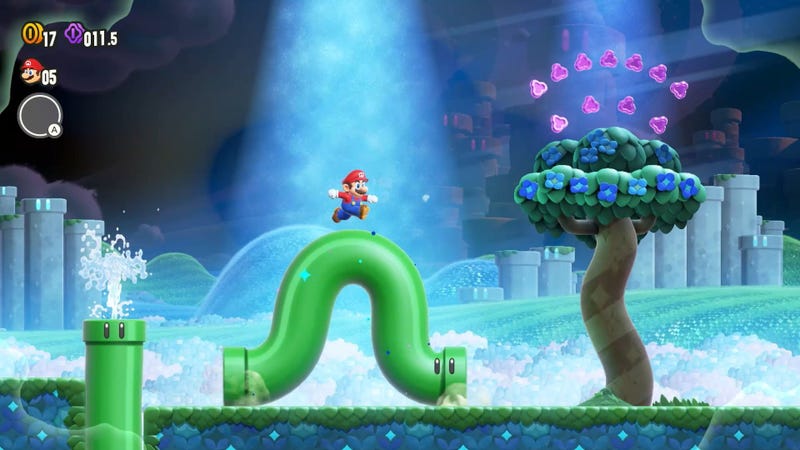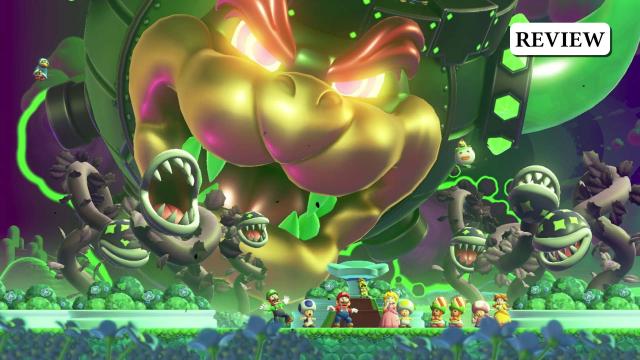First, the bad news: Super Mario Bros. Wonder doesn’t cure covid-19. Trust me on that. But, if you ignore that one flaw and focus on everything else—the gorgeous graphics, the immensely creative levels, the pitch-perfect music—it’s easy to see this is one of Nintnedo’s best Mario games in years.
Super Mario Bros. Wonder, out now on Switch, is the latest entry in Nintendo’s historic Mario franchise, and the first traditional 2D sidescroller starring everyone’s favorite plumber in over a decade. Wonder is also the first new Mario game to launch after the immensely popular animated film starring Chris Pratt and Jack Black. And let’s not forget, It’s also the first Mario game to feature a new voice actor as the famous Italian hero. All of that adds up to a weird, higher-than-normal amount of pressure and eyeballs on what was already a very hyped, highly anticipated Super Mario Bros. game.
Put in a similar situation, I’d suspect other studios and developers might play it extremely safe, creating something solid but familiar. Thankfully, history has shown us over and over that Nintendo isn’t like most other game companies, and Wonder is a testament to that.
At first glance, you might assume Super Mario Bros. Wonder is just another 2D Mario platformer, starring the iconic character, all his friends, the evil Bowser, and a plethora of new levels to hop through while collecting coins. And yes, that’s still the basic formula at work here in Wonder. But Nintendo uses that simple and proven design as a foundation for something wacky and fresh.
Wild, wacky weeds
This is most evident in the new Wonder Flowers, power-ups hidden in most levels that, when activated, trigger wild changes that alter how Mario looks, moves, or interacts with the world. These changes aren’t simple, either, like making Mario run a bit faster or making levels simply change color. Instead, Wonder Flowers dramatically and playfully throw out all the Mario rules and traditions veteran players might expect.
Once you trigger a flower, pipes may start to slink around like snakes, the world might become filled with water, Mario might turn into a super tall monstrosity or the entire level might stop and prompt you to answer some trivia questions.

Some of my favorite effects completely changed how I played the game, with one flower altering the perspective of the stage, turning Super Mario Bros. Wonder into a top-down action game instead of a 2D platformer. Another time, a flower turned me into a Goomba—unable to jump or move fast—and filled the level with enemies who wanted to eat me. This meant I had to time out my moves and use mushrooms to hide and…oh wait a minute, would you look at that! I’m playing a stealth game starring Mario.
None of these Wonder Flower experiences stick around too long, ending after a few minutes at most, and you can ignore the flower and complete the level normally if you so desire. But each time I started up a course in Wonder, I was excited to see the next creative twist on Mario. It reminded me of when I first played Super Mario 64 as a kid and didn’t know much about the series or what to expect. Each new enemy and new world threw me for a loop. And Wonder recreates that feeling of well…wonder that has been missing in so many 2D Mario games for so long.
It’s not just the Wonder Flowers that add to this sense of wonder, but Nintendo’s decision to stuff the game with mostly new enemies and power-ups. (Though some classics like the Fire Flower and Koopas do make a return, too.)
I’d often encounter some odd new enemy, like a walking firework shooter, and have to take a moment to figure it out. And once I had grokked it, I’d run into a new power-up—like the famous Elephant Fruit—and would then learn a new way to interact with or use it. Other power-ups like the Drill Helmet and Bubble Flower change how you explore levels or take out enemies. The result is that Super Mario Bros. Wonder feels endlessly fresh, and is one of the most creative video games I’ve played in a long time.
It’s fun, but is it hard?
Of course, all this wacky Wonder Flower stuff isn’t enough to make a Mario game good. The other big factor is how it actually feels to play, and Wonder nails this aspect perfectly.
Running and jumping feel weighty, but not too heavy. Mario has a sense of momentum and heft, but he doesn’t feel like a lead weight holding the action back. Likewise, he doesn’t bounce around wildly like a bouncy ball covered in grease. I always felt like I had complete control of Mario, no matter how wild things got. So when I landed a cool move or pulled off a tricky jump, I felt like I did it. And when Mario died, it was always my fault and I knew what I did wrong and how to not screw it up next time.
Now, just how often you fail in Super Mario Bros. Wonder is at the centre of some online discourse. It seems like many folks are worried that Nintendo’s latest platformer isn’t a tough-as-nails experience. And the short answer is, yeah, it’s not very hard. If you’ve played past Mario games and platformers, odds are you’ll end Wonder with a surplus of extra lives and not too many deaths. Even I, someone who isn’t a platformer pro, ended Wonder with nearly 80 extra lives, and that’s without abusing any glitches or exploits. But I’m fine with this.
If you want a super hard Mario game, the internet has spent years making ROM hacks and Mario Maker levels that will give you all the Kaizo action you could ever want.
I also think that some complaints about Wonder being “too easy” come from folks who have played hundreds or thousands of official Mario levels, fan hacks, and other monstrosities, and these people are just never going to be challenged by anything from modern-day Nintendo. And that’s okay. I prefer Nintendo to make creative and silly Mario games for the other 95% of players out there who just want to enjoy some Mario platforming without hair-pulling pixel-perfect precision platforming.
In other words, if you want a harder Mario game, there are plenty of options. However, I also acknowledge that Wonder could probably ramp up difficulty a tad without losing less-experienced players, especially in the first few worlds and courses, as some of those are almost mind-numbingly easy.

In Nintendo’s defense, Wonder does seem to try and placate both experts and newcomers with its badge system. Once equipped, the different badges you unlock throughout the campaign can let Mario jump higher, move faster, collect coins from defeating enemies, or even shoot a grappling hook.
Some of the weirder badges in Super Mario Bros. Wonder can make the game trickier to complete, like one that makes Mario hop all the time. Other badges have the opposite effect, adding blocks into levels to make them easier or giving Mario a Super Mushroom at every checkpoint or level start. It’s a system, like the Wonder Flowers, that seems designed to shake up the Mario formula but can also be ignored by players who prefer a pure platforming experience.
The best medicine
I guess, before I wrap this up, I should mention the game’s “story.” The creativity and freshness found in the rest of the game doesn’t extend to the story of Wonder, which features Bowser stealing some magical power and becoming a big threat, and Mario running through seven worlds to collect the needed resources to stop the famous villain.
It’s nothing too groundbreaking, though the final fight against Bowser is very good. But I don’t play Mario games for thrilling narratives or dramatic character arcs. I come back to these games because they—the best ones at least—make me smile, are endlessly inventive, and just feel good as heck to play.

I mentioned at the top that Super Mario Bros. Wonder didn’t cure my covid-19 infection, which is true, but I made that joke because if any video game could make someone feel physically better, this would be it.
Wonder is a gorgeous, cartoonish jolt of creativity and silliness that makes me smile each time I play it. I genuinely felt better after a few hours of Super Mario Bros. Wonder. It made me feel like a little kid again. Anything was possible in each of its courses, and by the end I had seen things I never expected to see in a Mario game. The feeling of playing Wonder didn’t cure my illness, but if I could bottle it and save it for a rainy day, I’d do it in a heartbeat.
Instead, I guess I’ll just play Wonder again the next time I need a pick-me-up. That’s easier and sounds like a lot more fun.

Leave a Reply